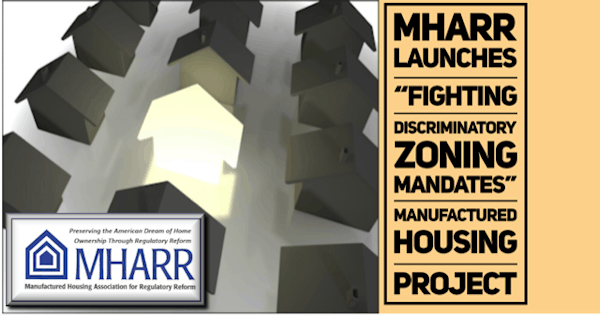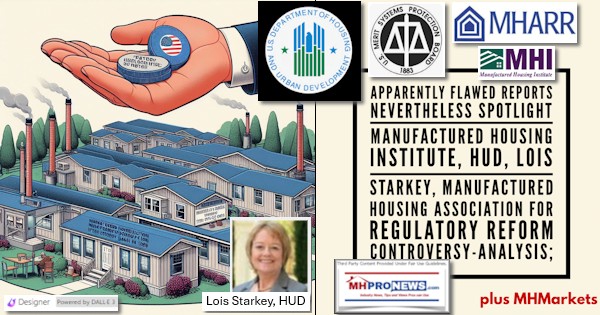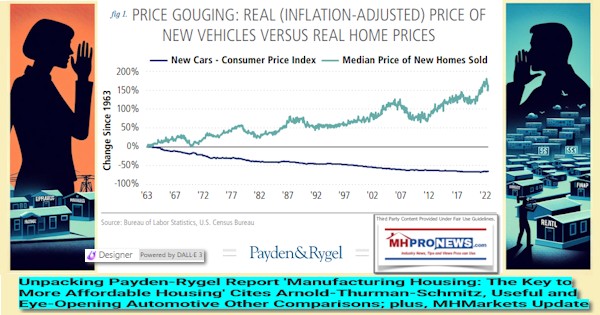
“…the Supreme Court could have ruled in favor of the Court of Appeals and ordered the
Goyings to tear down their home. That would have been tragic. But we are proud to be
a part of this ground-breaking ruling and proud of the homes our members build.”
– MHBA Executive Director Tom Hardiman.
“It was peace of mind for us that the industry we chose to spend our money with backed us up.
It gave us the confidence to continue fighting.”
– Helen Goyings
“The Timber Ridge Bay restrictive covenants unambiguously prohibit modular homes. The materials, workmanship, quality,
and outward appearance of the defendants’ home are indistinguishable from a site-built home.”
– Michigan State Supreme Court
In a media release to MHProNews, the Modular Home Builders Association (MHBA) Tom Hardiman introduced it by saying, “…we received word today from our attorneys that the Michigan State Supreme Court ruled in favor of the modular homeowner in a case involving restrictive covenants. To my knowledge this marks the first time someone has taken this all the way to a state supreme court and defeated a restrictive covenant. Most people simply won’t build modular if the HOA prohibits it.
I had the opportunity today to speak with the builder, Heritage Custom Builders, and also the homeowner, Helen Goyings. This family has fought and endured 4 years of legal battles and spent more money to keep their home than I care to share (it’s a lot!)…”
The MHBA release will be followed by a brief analysis and commentary by MHProNews.
Michigan Supreme Court Makes Historic Ruling in Favor of Industry-Backed Homeowner
The Michigan State Supreme Court recently handed down its ruling in the Thiel v Goyings case, involving a homeowner who utilized modular construction and a neighbor who opposed its use. MHBA filed an Amicus Brief in support of the homeowner in this case.
Background:
When David and Helen Goyings considered building their retirement home in Timber Ridge Bay neighborhood in Allegan, Michigan (north of Kalamazoo) they began speaking to Tim Cassidy at Heritage Custom Builders/Tim Cassidy Builders. “We’d seen some homes Tim built and were impressed with the quality,” Helen Goyings said in an exclusive phone interview with MHBA. “We liked that we were able to pick out and design our home the way we wanted because we didn’t want a cookie cutter home.” Goyings continued, “And, his homes were so well built, better insulation, thicker walls, and just a better product than the stick-built on-site home.”
Unfortunately for the Goyings, their neighbor didn’t like the idea at all. Once construction began and the three modules from Ritz Craft Corporation were delivered for installation, things turned nasty. Matthew Thiel owned a nearby home and opposed the Goyings use of modular components in their home construction, citing the Homeowners Association restrictive covenant. He took the Goyings to court demanding that their new dream home be torn down. Thus, began a four-year legal ordeal for the Goyings family.
After a three-day bench trial, the trial court found no cause of action and dismissed the case in favor of the homeowner. On appeal, the Court of Appeals concluded that the trial court erred and reasoned that the Goyingses’ home unambiguously fit the commonly understood definition of “modular” but never construed the disputed term used in the covenants— “modular home.” The restrictive covenant in question was written in 2006 and states:
“Manufactured Housing Units. No manufactured homes, whether classified as a mobile home, modular home, or otherwise, and no prefabricated homes shall be permitted on any Parcel in the Premises, regardless of which building codes are applicable to said homes.”
The panel reversed and held that the trial court should have granted judgment in the neighbors’ favor and ordered the Goyingses to tear down their new home.
“It was peace of mind for us that the industry we chose to spend our money with backed us up. It gave us the confidence to continue fighting.”
– Helen Goyings
But the Goyings were not done fighting and not willing to tear down their new retirement home. They appealed to the Michigan Supreme Court in hopes that their case would be heard. When asked if MHBA’s amicus brief helped her family’s case, Helen Goyings said definitively that it did. “It was peace of mind for us that the industry we chose to spend our money with backed us up. It gave us the confidence to continue fighting.” According to Helen, “the amicus briefs filed by MHBA and others were the biggest help in crossing the line to have the case heard by the court because the Court only took up thirty cases this year.”
In making their 5-2 ruling in favor of the Goyings, the Michigan Supreme Court stated in part “this is not a dispute about the definition of the word modular. And It’s also not a dispute about whether modular homes are nice. The dispute is about how the covenants define a modular home—that is, when does a home with modular components cross the line and become a modular home? How do we know a “modular home” when we see one?”
According to Heritage Custom Builders/Tim Cassidy Builders, the majority of the home would be stick-built on-site. This included the entire lower-level walkout basement, garage, roof gables, roofing, front porch, stone columns, deck, and other portions of the home. However, three modular components would be built offsite and delivered to the lot. All told, the completed home’s cost would be composed of about 59% stick-built construction and 41% modular components. This fact turned out to be the deciding factor in this case.
The parties did not dispute any of the (lower) trial court’s factual findings:
-It found that the testimony was uncontroverted that the overall quality of the Goyingses’ home would equal or surpass that of homes that are stick-built on-site.
-The completed home would be indistinguishable from a stick-built home in material quality and workmanship because the modules were constructed out of the same materials as a stick-built home and the construction methods used in the factory were the same as those used to build a home on-site.
-The home was subject to the same residential building codes as a stick-built home.
The lower court also found that the home’s hybrid construction would not be visible. It would be visually attractive, and, from appearances, “it would be unlikely that anyone would know that the home had been built anywhere but on the property.”
The court also determined that although the plaintiffs believed “that knowledge that the construction of the home involved three modules would reduce the value of the other homes in the area,” they did not present any evidence from an “appraiser, expert or other witness to support their belief.”
Finally, on the basis of testimony from the covenants’ drafter, the court determined that the purpose of the covenants was to protect the value of the parcels by maintaining a consistent standard of aesthetics, quality, and value for all homes built within the subdivision. The covenants prohibited manufactured homes, mobile homes, and modular homes on the basis of the assumption that such homes “are not typically going to be of a standard and of aesthetic appeal as what a stick-built home would be.”
In other words, the covenant was written in 2006 ASSUMING that a modular home would not look as nice as a site-built home and would therefore lower the value of nearby homes.
After a lengthy grammar lesson in their opinion, the Supreme Court landed on some key facts:
Ritz-Craft, the company that manufactured the modular components, might describe itself as a “ ‘modular home manufacturer,’ ” but the Goyingses did not purchase a modular home from Ritz-Craft; they contracted with Cassidy Builders and Heritage Custom Builders to construct a home that incorporated Ritz-Craft modules.
Though all these sources demonstrate that the Goyingses’ home is partly modular, they provide no guidance as to whether the modular components were extensive enough to violate the restrictive covenants.
The home does not fit the covenant definition of “relocated residence”—the modules were not a “residence” when placed on the lot. According to the builder, each component was “just a raw piece of construction material” and was “not even close” to being habitable without extensive on-site construction.
Nor does the Goyingses’ home breach the prohibition against “manufactured housing units.” The trial court found that the defendants’ home was mainly stick-built, with modular components integrated into it. And the Supreme Court agreed.
The Timber Ridge Bay restrictive covenants unambiguously prohibit modular homes. The materials, workmanship, quality, and outward appearance of the defendants’ home are indistinguishable from a site-built home.
Modular components don’t necessarily make a modular home. The covenants give us text and context to determine what a modular home is. A fair reading of those covenants prohibits a home that is more modular than not. And the Goyingses’ home is mostly not modular.
“The Timber Ridge Bay restrictive covenants unambiguously prohibit modular homes. The materials, workmanship, quality, and outward appearance of the defendants’ home are indistinguishable from a site-built home.” – Michigan State Supreme Court
What Does this Mean for the Industry Going Forward?
This ruling can only be described one way – historic! MHBA is not aware of any other case in the country where a restrictive covenant against a modular home was overturned. And to have the ruling come from a state Supreme Court is even more significant.

MHBA had to incur legal expenses to file the amicus brief in this case with absolutely no guarantee of a positive outcome. According to MHBA Executive Director Tom Hardiman, “the Supreme Court could have ruled in favor of the Court of Appeals and ordered the Goyings to tear down their home. That would have been tragic. But we are proud to be a part of this ground-breaking ruling and proud of the homes our members build.”
While this case was specifically about whether one home violated the language in its HOA, MHBA believes this ruling will have a ripple effect. “We are opposed to any restrictions that place modular construction at a disadvantage to site-built homes”, said Hardiman. “As we approach 2020, it’s ridiculous that we continue to have this conversation given the lack of skilled labor and low availability of affordable housing inventory in this country.”
Paul Lindsley of Ritz-Craft Homes had this to say about the ruling: “This is a landmark decision for our industry. Systems built product plays a key role in the housing business and that role will continue to grow as site labor challenges continue to mount. My hope is this sets a precedent for future housing discrimination cases, and that it also paves the way for the decision-making process a developer considers when establishing restrictive covenants.”
Tim Cassidy of Heritage Custom Builders/Tim Cassidy Builders witnessed many of the hearings and said, “the attorney for MHBA proved to be very helpful to the case. He was very informed and provided a lot of good insight as to what is happening in the industry.” Cassidy continued, “We are happy with the outcome of this case and for the Goyings family. We built a beautiful home for them and now they can enjoy it.”
MHBA, too hopes the Goyings family can finally enjoy their retirement home!
##
The meat of the Associated Press (AP) report on this controversy said, “Neighbors sued David and Helen Goyings, arguing they had violated a ban on modular or manufactured homes in the Timber Ridge Bay subdivision in Allegan County.
The house is 59% stick-built construction and 41% modular components. There’s a walkout basement, stone columns, garage and deck. The Goyingses chose builders that integrate modular components with traditional construction.
In a 5-2 opinion, the Supreme Court said Wednesday that no neighborhood covenants were broken. The court says “modular components don’t necessarily make a modular home.”
In dissent, justices Stephen Markman and Brian Zahra say the Goyings violated the rules and the house should come down.”
MHProNews Analysis
The decision is a historic one, based upon the various citations provided. As the ruling is nuanced, it still leaves some issues unsettled. But it may have ramifications beyond the modular home building industry.
“The MHBA certainly deserve credit for weighing in on this issue as they did,” said MHProNews publisher, L. A. ‘Tony’ Kovach. “They have every reason to celebrate, and we applaud their successful effort. But this legal battle also begs a perennial question. Why hasn’t the Manufactured Housing Institute [MHI], which for years has claimed to represent all segments of factory-built housing, not done similarly to what the MHBA did? Specifically, why hasn’t MHI gone to court if necessary in order to get manufactured housing’s enhanced preemption under federal law enforced? Why have they not used their vaunted clout to get HUD to act themselves under federal law?”
MHProNews will put that question to MHI, their executive committee, and their outside attorneys. We will report back to the industry in the days ahead. Stay tuned.
That’s the latest on modular and manufactured housing “Industry News, Tips, and Views Pros Can Use” © where “We Provide, You Decide.” © ## (News, analysis, and commentary.)

Soheyla is a managing member of LifeStyle Factory Homes, LLC, the parent company to MHProNews, and MHLivingNews.com. Connect with us on LinkedIn here and here.
Related Reports:
Click the image/text box below to access relevant, related information.
Manufactured Housing Institute – Seth Appleton, Hunter Kurtz Begin Key Roles at HUD – Analysis

NAR, Land Use, Property Rights, Declining Existing, New Housing Sales

























